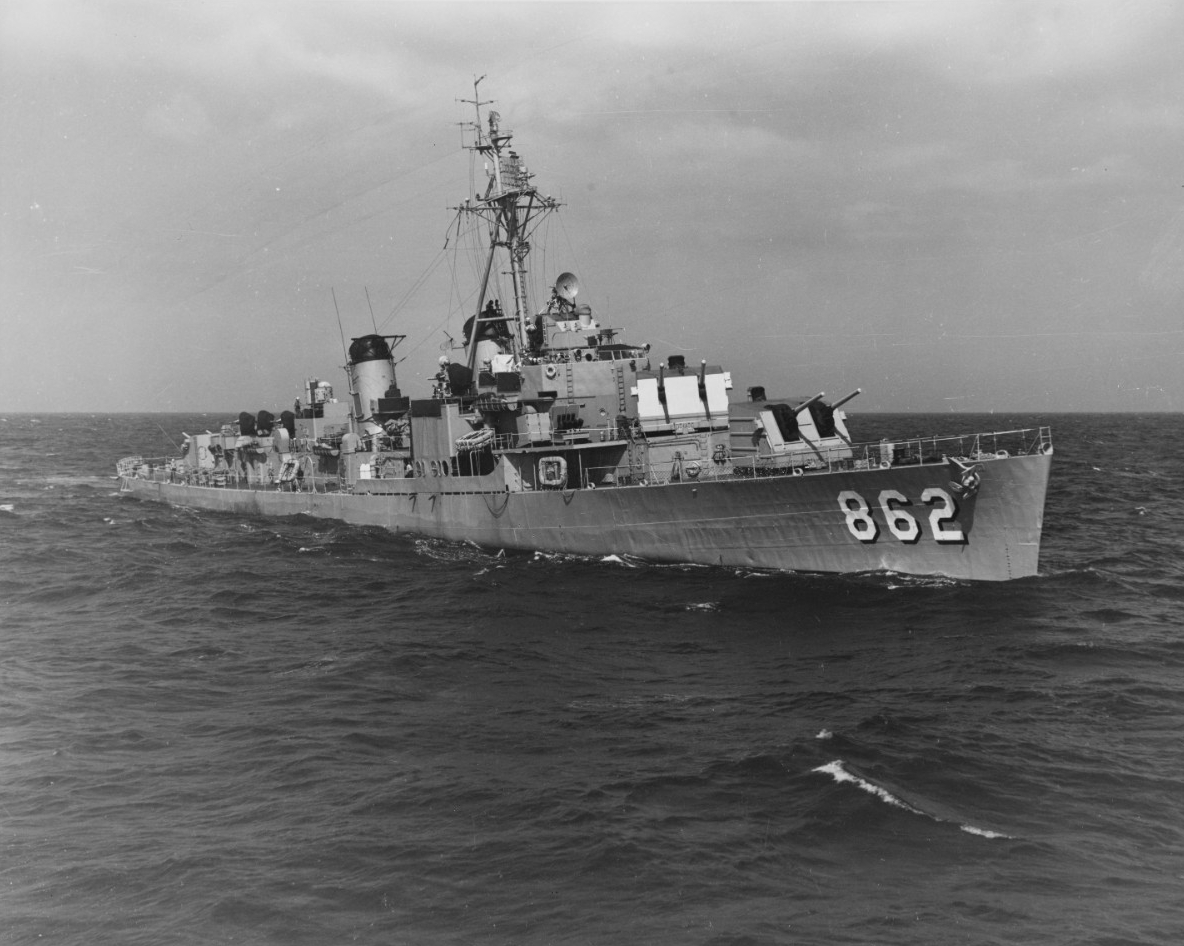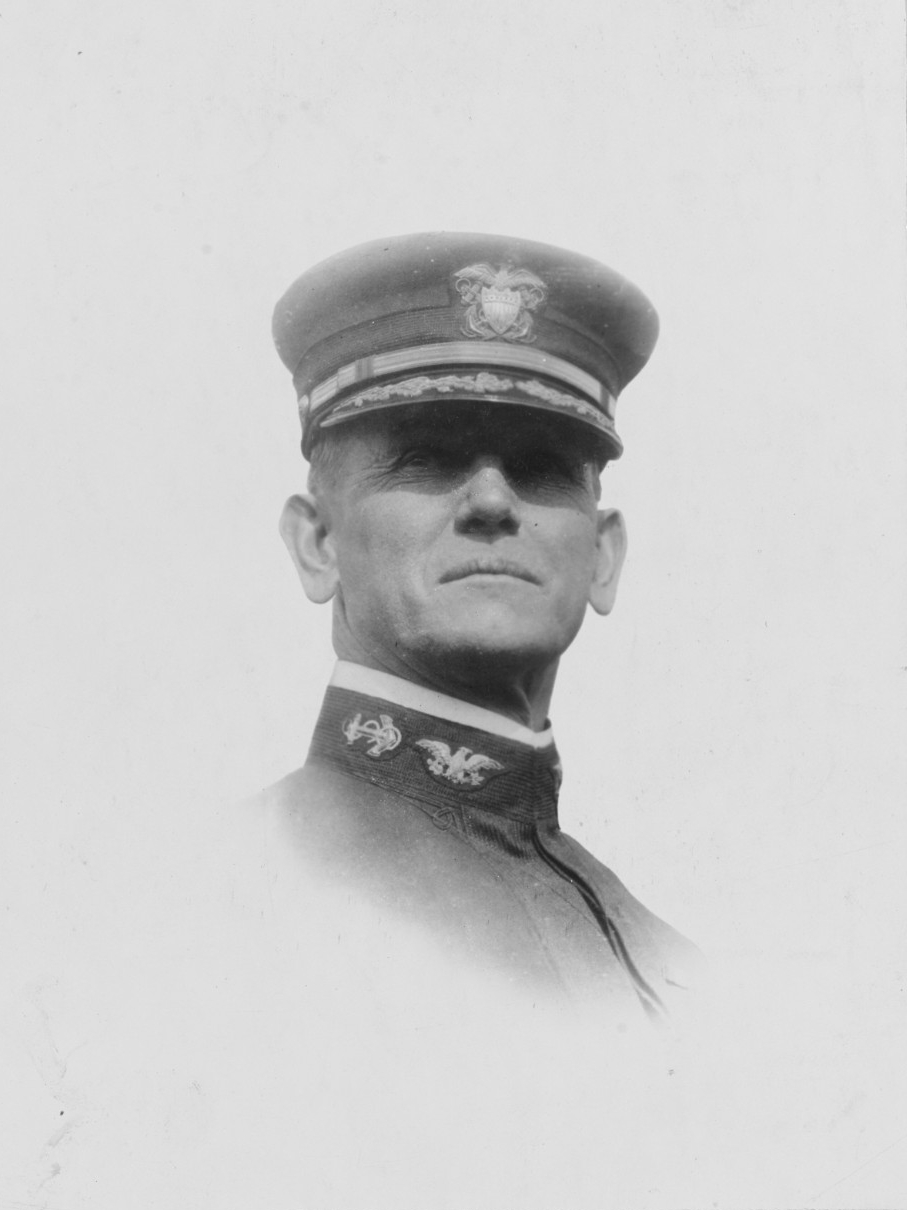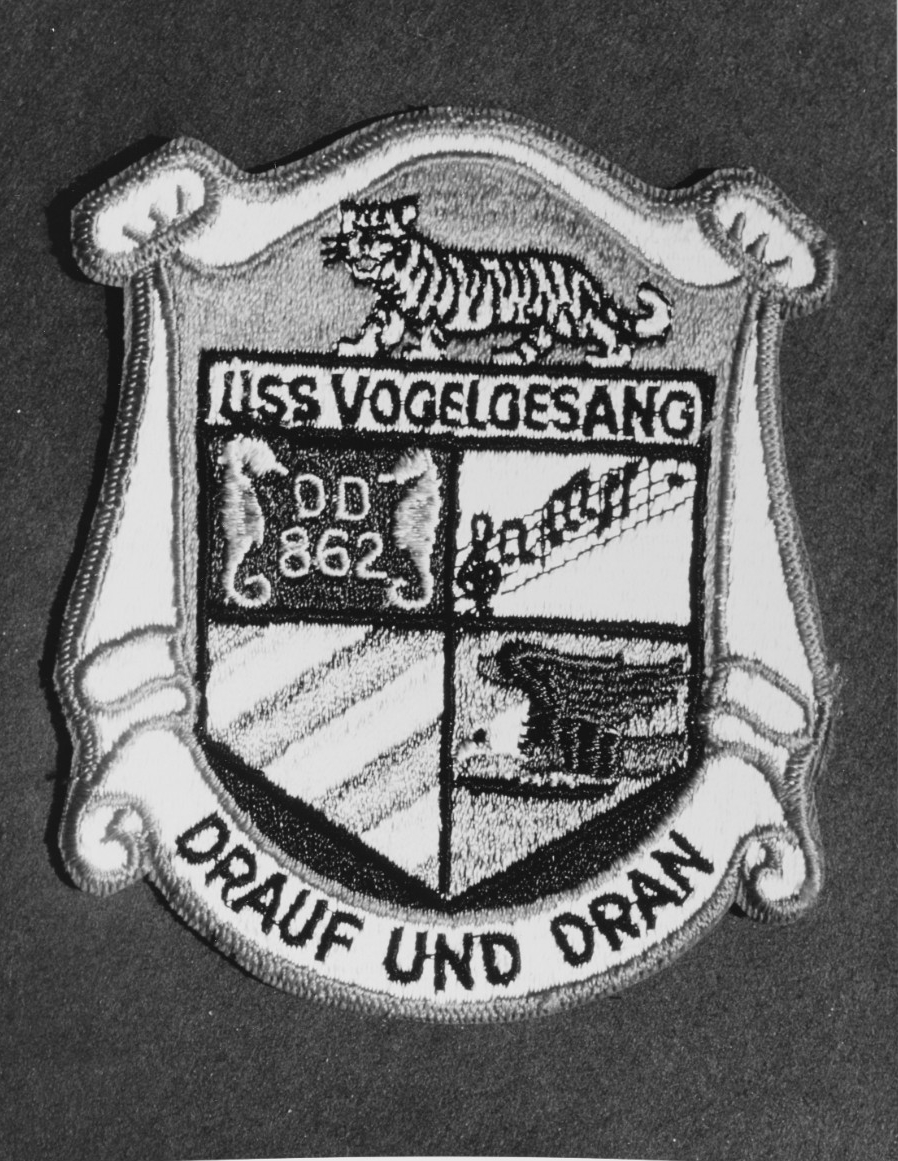Vogelgesang (DD-862)
(DD-862: dp. 2,425; 1. 390'6"; b. 40'10"; dr. 18'6"; s. 34.6 k. (tl.); cpl. 345; a. 6 5", 16 40mm., 5 21" tt., 1 dcp, (hh.), 6 dcp., 2 dct.; cl. Gearing)
Carl Theodore Vogelgesang, born on 11 January 1869 at North Branch, Calif., was appointed a naval cadet (the name at that time applied to young men studying at the Naval Academy) on 6 September 1886. On 6 June 1890, he graduated from the Academy and began active duty on board Alliance as a passed naval cadet. At the completion of his requisite two years of sea duty before final graduation, he was commissioned an ensign on 14 July 1892 to date from 1 July 1892. Successive tours of duty on board Adams and Mohican occupied his time until 1895 when he was ordered to Washington, D.C., for duty in the Bureau of Navigation. Detached from that post on 29 August 1896, Ens. Vogelgesang reported to the gunboat Bancroft on 3 September. That ship remained his home through the Spanish-American War. Vogelgesang served in her during convoy escort missions and on blockade duty off Havana and near the Isle of Pines. Tours of duty in Celtic and at the New York Navy Yard in conjunction with the fitting out of Kentucky (Battleship No. 6) and Wisconsin (Battleship No. 9) followed. On 6 June 1904, he returned to the Bureau of Navigation for a two-year tour of duty as navigator on board Louisiana (Battleship No. 19), during which he attained the rank of lieutenant commander on 1 July 1905. A fifteen-month assignment from June 1906 to September 1907 was followed by his first command, Mayflower.
That tour of duty ended in March 1908 when he transferred to Wisconsin as navigator. In May 1909, Lt. Comdr. Vogelgesang reported for duty ashore once more, this time to study at the Naval War College at Newport, R.I. On 2 May 1911, near the end of his assignment at the war college, Vogelgesang was promoted to full commander. On 2 May 1912, he transferred to Wyoming (Battleship No. 32) to fit her out. When she was commissioned, he assumed duty as her executive officer. In late January 1914, Cpmdr. Vogelgesang was ordered to Des Moines (Cruiser No. 15) which he commanded until 23 October. On 21 November 1914, he reported for duty at the Naval War College and remained there until the beginning of 1917, when he became Chief of Staff to the Commander in Chief, Asiatic Fleet. Just after assuming the duties of that office, he received his promotion to captain, to date from 29 August 1916. In January 1918, Capt. Vogelgesang relinquished his position as Chief of Staff to the Commander in Chief Asiastic Fleet, and reported to Rio de Janeiro, Brazil, as senior officer of the American naval commission.
On 9 January 1919, Capt. Vogelgesang took charge of the fitting out of Idaho (Battleship No. 42) at Camden, N.J., and assumed command of her when that battleship was placed in commission on 24 March 1919. He commanded Idaho until June 1920 when he became the Chief of Staff to the Commander in Chief, Atlantic Fleet. A year later, Capt. Vogelgesang became Commandant, 3d Naval District, at New York. That tour of duty lasted until November 1922 when he received orders to organize and lead the United States Naval Mission to Brazil. For the next two years, he and his staff joined their Brazilian counterparts in reorganizing the Brazilian Navy. During his two years in Brazil, he helped to strengthen the warm and enduring friendship between that nation and the United States. Early in that assignment, he was promoted to rear admiral, to date from 16 October 1922. Rear Admiral Vogelgesang completed his mission in South America in January 1925 and returned to the United States on 7 February. On 3 April, he broke his flag in New York (BB-34) and became Commander, Battleship Division 2 of the Scouting Fleet. In June 1926, he was detached from command of Battleship Division 2 and took command of the Light Cruiser Division, Scouting Fleet. That tour of duty was abbreviated when Rear Admiral Vogelgesang entered the Naval Hospital, Washington, D.C., for treatment of a kidney ailment. He died there on 16 February 1927.
Vogelgesang (DE-284), a Rudderow-class destroyer escort, was laid down by the Charleston Navy Yard sometime in 1943. However, before she was launched, her contract was cancelled on 10 June 1944.
I
Vogelgesang (DD-862), was laid down on 3 August 1944 at Staten Island, N.Y., by the Bethlehem Steel Co.; launched on 15 January 1945; sponsored by Miss Senaide Vogelgesang; and commissioned on 28 April 1945 at the New York Navy Yard, Comdr. O. W. Spahr in command.
Vogelgesang conducted shakedown training out of Guantanamo Bay, Cuba, from mid-May to late June and returned to New York on the 24th for post-shakedown availability. In July, she moved to Newport, R.I., for gunnery exercises and, in August, began duty at Norfolk as a training platform for destroyer nucleus crews. In October, she interrupted her training schedule to take part in the Navy Day festivities at New York but resumed those duties in November. For the next two years, the destroyer operated out of Norfolk, along the east coast, and in the West Indies, conducting exercises both independently and in company with other units of the Atlantic Fleet. On 10 November 1947, she stood out of Norfolk on her first deployment to the Mediterranean Sea. She arrived at Gibraltar on 20 November and, after a little more than three months of exercises and port visits, departed the "middle sea" on 2 March 1948.
The warship arrived back in Norfolk on 11 March and resumed a normal schedule of 2d Fleet operations. She ranged up and down the east coast until 4 January 1949 at which time she headed back to the Mediterranean. Vogelgesang completed her second deployment to the 6th Fleet on 14 May, departed Gibraltar that day, reentered Norfolk on the 23d, and commenced a two-month upkeep period.
Over the next eight years, Vogelgesang alternated five deployments to the Mediterranean with tours of duty along the east coast and in the West Indies. In addition, she also visited northern European ports during the summer of 1956 while on a midshipman training cruise. Her five Mediterranean tours consisted of normal training operations with units of the 6th Fleet and with elements of Allied navies as well as port visits at various points throughout the Mediterranean. In 1957, there came a change in Vogelgesang's routine of the previous eight years. She deployed to the Mediterranean once more in July; but, on this deployment, she added something new to her schedule. That new item was service in the Indian Ocean, for she added Aden and Massawa in Eritrea to her list of ports of call. In December, when she returned to the Mediterranean for another deployment with the 6th Fleet, she again transited the Suez Canal, repeated her former visits to middle eastern ports, and added Bahrein Island and Abadan, Iran, to her itinerary.
During the following nine years, Vogelgesang continue her schedule of alternating Mediterranean cruises and 2d Fleet operations. However, some special assignments highlighted her service. In 1961 and 1962, she provided support for the Project "Mercury" space shot.
On 1 March 1962, she entered the Boston Naval Shipyard to begin a fleet rehabilitation and modernization (FRAM) overhaul. For the next 10 months, she underwent extensive structural changes as well as equipment installation to improve greatly her antisubmarine warfare capabilities. She completed her FRAM conversion on 31 January 1963 and resumed normal operations put of Norfolk. In 1964, she participated in two binational exercises with Canadian ships, CANUS SILEX in March and CANUS SLAMEX in September.
In October and November, she returned to European waters to participate in a large amphibious exercise, Operation "Steel Pike I," carried out on the Atlantic coast of Spain. In January of 1965, the warship served as part of the Project "Gemini" recovery force which picked up an unmanned experimental Gemini space capsule. In June, she deployed to the Mediterranean once again for a two-month tour of duty with the 6th Fleet. Vogelgesang resumed 2d Fleet operations early in September following another joint United States-Canadian exercise in August on her way back from Europe. On 3 December, she began her first regular overhaul since her FRAM conversion when she entered the Norfolk Naval Shipyard.
Vogelgesang completed overhaul and sea trials on 22 March 1966 and resumed normal duty with the Atlantic Fleet. That assignment lasted until 1 June at which time she and the other ships of Destroyer Squadron (DesRon) 32 steamed out of Norfolk for a deployment to the western Pacific. Steaming by way of the Panama Canal, Pearl Harbor, and Guam, she and her colleagues reported for duty with the 7th Fleet at Subic Bay in the Philippines on 15 July. On the 19th, she headed for the Gulf of Tonkin in the screen of Constellation (CVA-64). The task group arrived in the gulf on 28 July, and Vogelgesang provided antisubmarine defense and plane guard services as the carrier's air group struck at targets in North Vietnam. On 15 August, the destroyer closed the shores of South Vietnam to provide gunfire support for troops operating ashore. On the night of 18 and 19 August, her 5-inch guns succeeded in breaking up a company-strength Viet Cong attack on a Popular Forces outpost near Dien Huong. Reports credited her main battery with killing 70 and wounding 40 of the attacking guerrillas. In addition to service in Vietnamese waters, the warship made visits to Hong Kong and Kaohsiung on Taiwan as well as periodic stops at Subic Bay for upkeep and replenishments. Vogelgesang concluded her only combat cruise during the Vietnam conflict on 10 November when she stood out of Subic Bay, bound, via the Indian Ocean, the Suez Canal, and the Mediterranean Sea, for Norfolk. She completed her round-the-world cruise at her home port on 17 December.
After post-deployment standdown, Vogelgesang resumed her schedule alternating Mediterranean cruises with operations out of Norfolk. She spent the first 10 months of 1967 engaged in training operations along the east coast and in the West Indies. On 14 November 1967, the warship stood out of Norfolk for her first tour of duty with the 6th Fleet since 1965. On 24 November, she conducted turnover ceremonies at the Spanish island of Majorca and officially joined the 6th Fleet. For the next five months, the destroyer ranged the length and breadth of the Mediterranean, conducting training evolutions and making port visits. On 13 April 1968, she departed Malaga, Spain, to return to Norfolk.
After a 10-day transit, she reentered her home port on the 23d. She resumed normal 2d Fleet operations until 22 July at which time she departed Norfolk for a cruise to South American waters to participate in UNITAS IX, a series of multinational exercises with units of various Latin American navies. She concluded that assignment on 3 September when she reentered Norfolk.
Normal operations and a series of tender availabilities in preparation for overhaul occupied her time from September of 1968 to June of 1969. On 2 June 1969, she departed Norfolk, en route to Boston. The warship entered the Boston Naval Shipyard and commenced regular overhaul on 5 June. She concluded sea trials successfully late in September and departed Boston on 3 October and arrived in Norfolk on the 5th. For the remainder of the year, the ship conducted post-repair exercises and refresher training in the Guantanamo Bay operating area. She returned to Norfolk on 14 December and remained in port for the rest of the year.
Normal operations out of Norfolk occupied her until 30 April 1970 at which time she embarked upon another Mediterranean tour of duty. She changed operational control to the 6th Fleet on 10 May and conducted turnover at Majorca between the 12th and the 17th. For the first four months of the deployment, Vogelgesang conducted normal 6th Fleet operations: port visits and training evolutions. However, early in September, she joined a special contingency force assembled in the eastern Mediterranean in response to Syrian intervention in the Jordanian civil war on the side of militant, antigovernment, Arab guerrillas. She cruised that portion of the sea from 5 September to 6 October. Finally, however, the American show of force succeeded in getting the Syrian forces to withdraw from Jordan, and Vogelgesang resumed normal operations with the 6th Fleet. On 8 November, she departed Palma de Majorca to return home.
The warship reentered Norfolk on 17 November and remained there through the end of the year. The destroyer resumed normal 2d Fleet operations early in 1971 and remained so occupied for the next 11 months.
On 1 December 1971, she departed Norfolk for another tour of duty with the 6th Fleet in the Mediterranean. She arrived in port at Rota, Spain, on the 9th and conducted turnover ceremonies. For the following six months, Vogelgesang operated throughout the Mediterranean, engaged in the usual round of exercises and port visits. After turnover in Rota, the destroyer got underway on 23 June to return to Norfolk.
On the 29th, she steamed into Hampton Roads and soon began a tender availability alongside Sierra (AD-18). She conducted operations out of Norfolk until 10 October at which time she began an extended repair period at the Norfolk Shipbuilding & Drydock Corp. The warship completed repairs on 26 January 1973 and finished sea trials by early February. She conducted normal operations for the remainder of the year, steaming as far south as the West Indies.
On 10 January 1974, Vogelgesang was transferred from DesRon 2 to DesRon 28 and reassigned to Naval Reserve training duty. On 1 March, her home port was changed from Norfolk to Newport, R.I. On 19 March, she headed out of Norfolk, bound for her new home port, where she arrived the following day. Since that time, Vogelgesang has operated at and out of Newport as a training platform for naval reservists, NROTC midshipmen, and OCS students. She alternated short periods at sea with weeks in port as a stationary training platform. Periodically, however, she has made extended training cruises down the east coast to the West Indies. As of the beginning of 1980, the destroyer continued to serve with the Naval Reserve training program, based at Newport, R.I.
Vogelgesang earned two battle stars for service during the Vietnam conflict.





